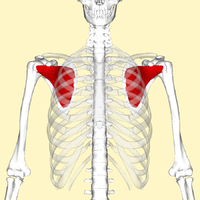
Photo from wikipedia
BACKGROUND The influence of preoperative rotator cuff fatty infiltration (FI) and muscle atrophy (MA) on the postoperative outcome of total shoulder arthroplasty (TSA) has only rarely been investigated and reported… Click to show full abstract
BACKGROUND The influence of preoperative rotator cuff fatty infiltration (FI) and muscle atrophy (MA) on the postoperative outcome of total shoulder arthroplasty (TSA) has only rarely been investigated and reported in the literature. We hypothesized that more FI and MA would be associated with a worse postoperative functional outcome. METHODS This prospective cohort study included 63 patients (31 female and 32 male patients; mean age, 71 years [range, 53-89 years; standard deviation, 7 years]) with primary osteoarthritis of the shoulder operated on with anatomic stemless TSA. Preoperatively and at 3 months and 1 year after the operation, the functional outcome (QuickDASH [short version of Disabilities of the Arm, Shoulder and Hand questionnaire] score) and range of motion (ROM) (goniometer) and strength (dynamometer) for abduction at the scapular plane and for external rotation were measured. The degree of preoperative FI and MA was evaluated using computed tomography scans according to the Goutallier classification and Warner classification, respectively, for the supraspinatus and infraspinatus. RESULTS We found clinically and statistically significant improvements in functional outcome, strength, and ROM at both 3 months and 1 year of follow-up compared with those preoperatively. The Pearson correlation coefficient (r) showed significant correlations between preoperative supraspinatus and infraspinatus FI and MA and preoperative and 1-year postoperative shoulder abduction and external rotation strength but not ROM. However, we found no influence of the rotator cuff FI and MA on the functional outcome after TSA. CONCLUSION We demonstrated a significant correlation between rotator cuff FI and MA and strength but not ROM of the shoulder joint.
Journal Title: Journal of shoulder and elbow surgery
Year Published: 2018
Link to full text (if available)
Share on Social Media: Sign Up to like & get
recommendations!